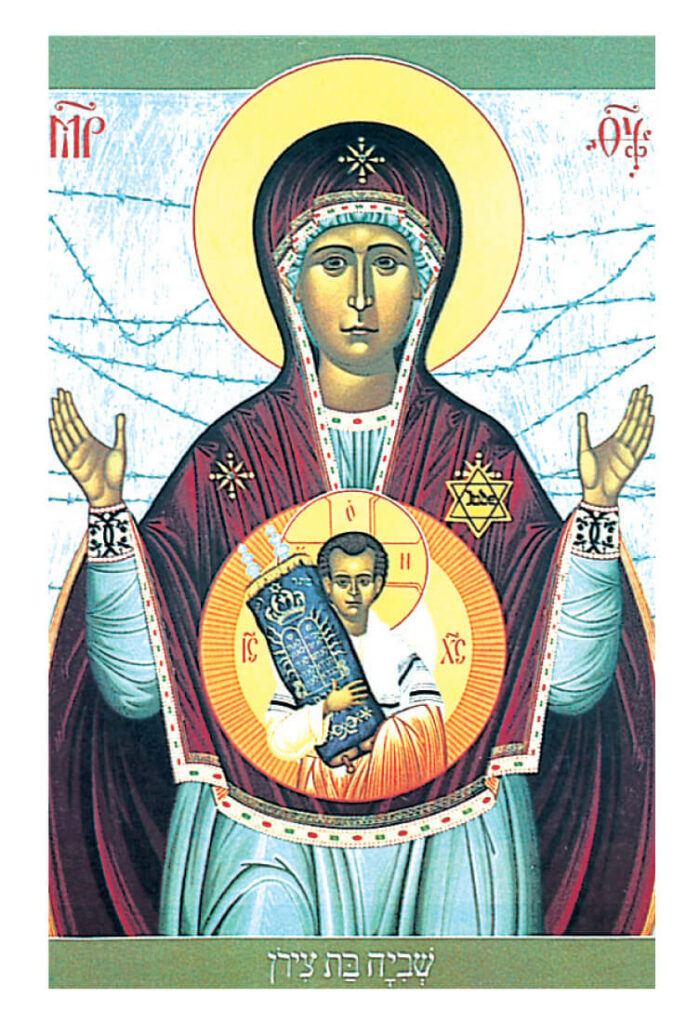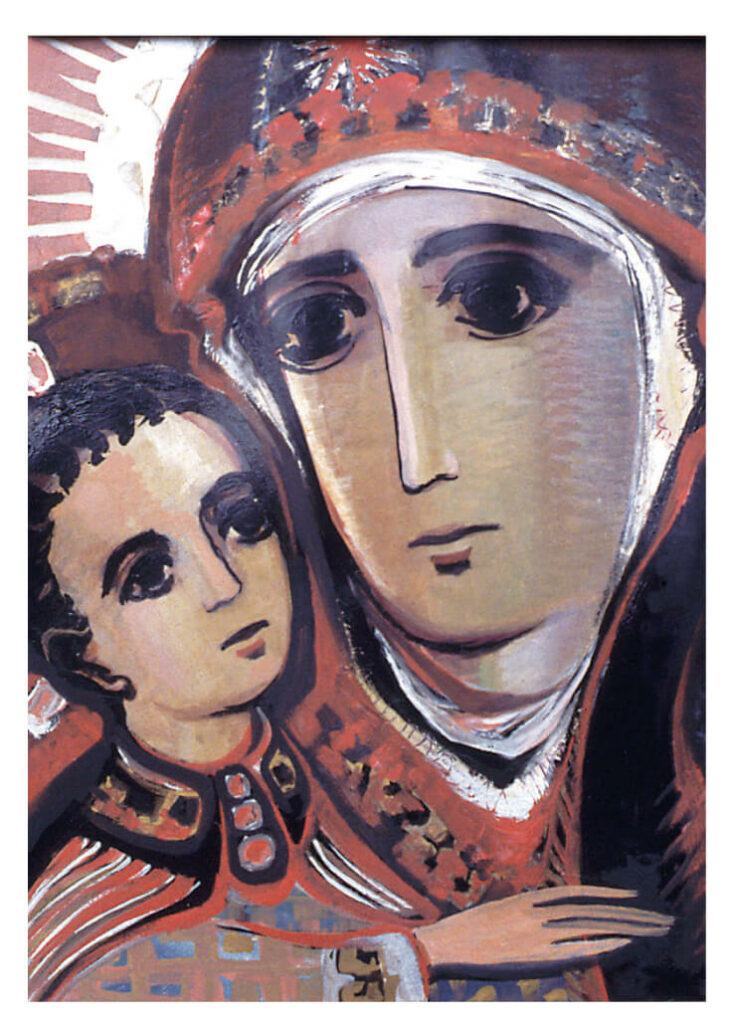
As a means of reflecting on Mary, the Mother of God, Sunday’s gospel offers only a single sentence. That sentence turns on the single word pondered. This word suggests her character in the narrative. Mary ponders all she has heard from the shepherds and surely how she wound up in a stable giving birth.
Symballein is the Greek word that the word ponders translates. Literally the word means to throw together, to wrestle with together. Sym is a prefix meaning with. Ballein is verb meaning throw. For Mary to ponder is to interpret the events that her life is throwing at her. Her faith is seeking understanding.
Earlier in Luke’s narrative the Angel Gabriel announces to Mary that she will conceive in her womb and bear a son, whom she will name Jesus. He will be great and will be called the Son of the Most High (Luke 1.30-32).
The angel’s words perplex Mary, another verb that hints an active mind. The promise makes no sense to her, so she questions the angel. How can she have a child when she is a virgin; she has had no sexual relations with Joseph. This detail suggests Mary is very young. Girls commonly married soon after they began to menstruate and could bear children.
- What verb expresses how you imagine Mary receiving the shepherds’ news—ponders, treasures, interprets, accepts, mulls over, weighs, thinks about, reflects on, theologizes?
In Mark’s gospel we meet Mary more than perplexed about her son. Jesus is already an adult. People from all over Israel, are coming to Galilee to hear Jesus and seek healing. His family hears that Jesus is attracting crowds and goes to stop him because people are saying, “He has gone out of his mind” (3.21). This delegation includes his mother and brothers.
When they arrive, Jesus keeps his blood family outside the house where he is teaching. He refuses to see them, redefines family, and opens his community to all. “Whoever does the will of God is my brother and sister and mother” (3.35).
This scene prevents us from thinking that Mary knows her son’s mission and willingly accepts all that Jesus does. Mary is full of grace but an ordinary human person. She has to interpret what happens in her life and the life of her son as events unfold.
In Mark’s gospel Mary fears for her son. Jesus is stirring up unrest in Galilee; Jewish religious leaders and/or the occupying Roman soldiers will come down on him. In this scene Mary is a mother who sees her child endangering himself and perhaps his kin, going beyond what she ever imagined he would do. She goes in person to challenge and protect him. But he doesn’t listen to his mother.
- What do you imagine Mary pondering at 15 when Jesus is born? At 45 when Jesus starts his ministry?
- When have your children challenged you to grow beyond your dreams for them?
Until Jesus’ rising from the dead and the coming of his fiery Spirit upon the community at Pentecost, Mary was a practicing Jewish woman, who keeps the law of Moses and worships at the temple. Robert Lentz’s icon of Mary as a Daughter of Zion pictures her wearing the yellow star and identifying with the Jews exterminated in the Holocaust. Jesus holds the commandments. Find prints at trinitystores.com.

In the first two chapters of his gospel, Luke surrounds Jesus’ birth with echoes from Israel’s sacred scriptures to interpret the event. His narrative makes theological claims about who Jesus is rather than record simple historical information. By making claims about Jesus, Luke recognizes Mary’s significance in Israel’s history.
The angel assures Mary that God is with her and that nothing is impossible with God. These words repeat the promise the three strangers make to Sarah and Abraham. Nothing is too wonderful for God to do; long-barren Sarah will have a child next year. Luke sees in Jesus’ birth God’s promise once again fulfilled.
Mary’s fiat is a typical response to a prophetic call. The angel explains the Holy Spirit will overshadow Mary; her child will be the Son of God. Mary responds as other prophets in Israel’s history have responded to God’s call, “Here I am.” I am present, ready to serve you.
Centuries of devotion obscure who Mary was in history. However, geography, social science, and archaeology can help sketch the life of a Jewish peasant woman, living in Galilee 2,000 years ago. To visit Elizabeth, Mary walks from Nazareth to a town near Jerusalem 75 miles away. When Joseph has to register for a census in Bethlehem, Mary travels with him from Nazareth to Bethlehem, just south of Jerusalem. Did she walk or bump along on a donkey as she neared full term of her pregnancy?
Economically Mary belongs among the 90% of the people who were poor in Israel, who paid temple taxes and Roman taxes. Excavations in Nazareth find houses built around courtyards, where people ground flour, prepared meals, fed their animals, and cared for one another’s children. The houses have dirt floors. Mary belongs to a social class that works hard to survive and provide for their families.
Significantly in Luke’s birth narrative, Mary and Joseph can find no place to stay in Bethlehem. Mary has her first child in a stable or cave for animals. The sign the shepherds find is the savior, lying in a manger, born among the poor, one of them.
In Truly Our Sister, Elizabeth Johnson invites us to recognize all Luke sums up in the words, “And she gave birth.”
The phrase recalls women’s pain and strength involved in laboring, sweating, counting contractions, breathing deeply, crying out, dilating, pushing hard while riven to the very center of one’s being with unimaginable bursts of pain, until slowly, slowly, the baby’s head finally appears and with more pushing the little creature slips from the birth canal, to be followed by the discharge of the placenta, with much bleeding, and then deep fatigue, breasts swollen with milk, and unpredictable hormonal swings. …Real blood was shed at this delivery, by a poor woman of peasant society far from home, laboring in childbirth for the first time. And it was holy (277).
- How does the Mary of history compare with the Mary of your devotion?
Many women theologians today seek to rescue the real Mary of history from the idealized Virgin Mother of doctrine and devotion. Idealizing Mary distances her from ordinary women. She becomes one of a kind, unlike the rest of us, immaculately conceived and uniquely assumed into heaven. She becomes an nearly divinized icon rather than a model disciple who struggles to understand her son.
In Church history, male theologians have too often imagined Mary as the ideal meek, submissive woman who knows her place in support of her Son. What about her public witness at the cross? What does she do with the fiery tongue she received at Pentecost? How does she influence the infant Christian community in Jerusalem?
- What do you imagine Mary doing after Pentecost?
